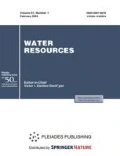Abstract
The forked channel is a rare and poorly known type of branching channel, the distribution of flow in which is of key importance for water transport, economic activities, and water resources development. The article is the first to analyze the distribution of the flow of water and suspended sediments between the major two branches of the forked channel of the Lower Ob, i.e., the Malaya Ob and the Gornaya Ob, numerous floodplain channels (branches), responsible for hydraulic interaction between them and the Severnaya Sos’va, a large tributary of the Lower Ob. It is shown that water discharges vary widely in both branches because of the secondary separation of branch channels, the distribution of flow among branches, deviation of sometimes considerable part of flow into floodplain channels (branches) and its return further downstream. General tendencies are revealed in water flow distribution in forked channes, and the mechanisms governing water flow distribution between the branches are described. A considerable effect on the Malaya Ob is due to its hydraulic interaction with the Severnaya Sos’va through floodplain channels, which withdraw an appreciable portion of water flow of the former. The development of the channel of the Gornaya Ob features a considerable limiting effect of the right main bank. During floods, both branches of the forked channel of the Lower Ob, at low turbidity, show a tendency toward decrease downstream. However, the downstream decrease in the solid discharge is more pronounced, reflecting the general trend in sediment accumulation in the Lower Ob.





Similar content being viewed by others

REFERENCES
Alekseevskii, N.I. and Chalov, S.R., Gidrologicheskie funktsii razvetvlennogo rusla (Hydrological Functions of a Forked Channel), Moscow: Geograf. Fak. Mosk. Gos. Univ., 2009.
Baidin, S.S., Stok i urovni vody v del’te Volgi (Water Flow and Levels in the Volga Delta), Moscow: Gidrometeoizdat, 1962.
Borik, S.A., Integrated experimental studies and estimation of the effect of channel quarries on the hydrological regime of a lowland river: a case study of the Lower Dnestr, Extended Abstract of Cand. Sci. (Geogr.) Dissertation, OGML, Odessa, 1987, 17 p.
Dugina, I.O. and Sal’nikov, V.I., The redistribution of Amur flow at Khabarovsk, in Tez. dokl. Vseros. gidrol. S’’ezda. Sektsiya 6. Problemy ruslovykh protsessov, erozii i nanosov (Abstracts of Reports of the Russian Hydrological Congress. Section 6. Problems of Channel Processes, Erosion, and Sediments), St. Petersburg, 2004, pp. 68–70.
Ermakova, A.S. and Kirik, O.M., Channel morphology and transformations in the Ust’-Aldanskii segment of the Lena, Geomorfologiya, 2006, no. 2, pp. 62–83.
Zaitsev, A.A., Ivanov, V.V., Korotaev, V.N., Labutina, I.A., Luk’yanova, S.A., Li Tszunsyan’, Rimskii-Korsakov N.A., Rychagov G.I., Svitoch A.A., Sidorchuk A.Yu., and Chernov A.V., Nizhnyaya Volga: geomorfologiya, paleogeografiya, i ruslovaya morfodinamika (Lower Volga: Geomorphology, Paleogeography, and Channel Morphodynamics), Moscow: GEOS, 2002.
Ivanov, V.V., Korotaev, V.N., Pronin, A.A., Rimskii-Korsakov, N.A., and Chernov, A.V., Floodplain geomorphology and channel dynamics of the Lower Don channel, Vest. Mosk. Univ., Ser. 5, Geografiya, 2013, no. 6, pp. 63–67.
Kamyshev, A.A., Ruleva, S.N., and Chalov, R.S., Water flow distribution in channel branching of the Middle Ob, Geograf. Vestn., 2017, no. 3, vol. 42, pp. 48–53.
Mikhailov, V.N., Rogov, M.M., Makarova, T.A., and Polonskii, V.F., Dinamika gidrograficheskoi seti neprilivnykh ust’ev rek (Dynamics of the Hydrographic Network of Nontidal River Mouths), Moscow: Gidrometeoizdat, 1979.
Simonov, A.I., Gidrologiya ust’evoi oblasti Kubani (Hydrology of Kuban Mouth Area), Moscow: Gidrometeoizdat, 1958.
Chalov, R.S., Geograficheskie issledovaniya ruslovykh protsessov (Geographic Studies of Channel Processes), Moscow: Mosk. Gos. Univ., 1979.
Chalov, R.S., Morphological types of branching lowland river channels, Vodn. Resur., 1998, vol. 25, no. 2, pp. 179–185.
Chalov, R.S., Ruslovedenie: teoriya, geografiya, praktika (Channel Studies: Theory, Geography, and Practice), vol. 1, Ruslovye protsessy: factory, mekhanizmy, formy proyavleniya i usloviya formirovaniya rechnykh rusel (Channel Processes: Factors, Mechanisms, Manifestation Forms, and Formation Conditions of River Beds), Moscow: Izd. LKI, 2008.
Chalov, R.S., Intricately braided river channels of lowland rivers: formation conditions, morphology, and deformation, Water Resour., 2001, vol. 28, no. 2, pp. 145–150.
Chalov, S.R. and Fedorovskii, A.N., Branching of rivers in the Northern Dvina basin, Vod. Khoz. Rossii, 2009, no. 6, pp. 37–52.
Chalov, R.S., Chalov, S.R., and Alekseevskii, N.I., Structural formation levels and typiphication of river channel branching, Vest. Mosk. Univ., Ser. 5, Geogr., 2011, no. 4, pp. 8–15.
Chernyshov, F.M., Povyshenie effektivnosti putevykh rabot na mnogorukavnykh uchastkakh rek (Improving the Efficiency of Channel Operations in Multibranch River Segments), Novosibirsk: Izd. NIIVT, 1973.
Egozi, R. and Ashmore, P., Experimental analysis of braided channel pattern response to increased discharge, J. Geophys. Res. Earth. Surf., 2009, pp. 941–962.
Latrubesse, E.M., Patterns of anabranching channels: the ultimate end-member adjustment of mega rivers, Geomorphology, 2008, vol. 101, nos. 1–2, pp. 130–145.
Schuurman, F. and Kleinhans, M.G., Bar dynamics and bifurcation in a modelled braided sand-bed river, Earth. Surf. Process Landforms, 2015, vol. 40, no. 10, pp. 1318–1333.
Funding
This study was carried out under Governmental Order to the Chair of Land Hydrology and Makkaveev Laboratory of Soil Erosion and Channel Processes, the Faculty of Geography, Moscow State University (no. AAAA-A16-116032810084-0: Morphodynamic Typiphycation of Forked Channels); the study was supported by the Russian Science Foundation (project no. 18-17-00086: Field Studies, Water and Sediment Runoff in Bifurcations at Different Levels) and the Russian Foundation for Basic Research (project nos. 19-35-90 101: Hydromorphology and Transformations of Wide-Floodplain Channels of Largest Lowland Rivers: Case Study of the Ob and Lena; 18-05-48: Spatial Manifestations of the Extreme Low Water in a Waterway); the study was technically supported by the Adminisration of the Ob–Irtyshvodput’ and Khanty-Mansi District Department of Waterways.
Author information
Authors and Affiliations
Corresponding authors
Additional information
Translated by G. Krichevets
Rights and permissions
About this article
Cite this article
Chalov, R.S., Kamyshev, A.A., Kurakova, A.A. et al. The Distribution of Water and Suspended Sediment Flow during Spring Flood in the Forked Channel of the Lower Ob (Within Khanty-Mansi Autonomous Area). Water Resour 48, 18–28 (2021). https://doi.org/10.1134/S0097807821010127
Received:
Revised:
Accepted:
Published:
Issue Date:
DOI: https://doi.org/10.1134/S0097807821010127



